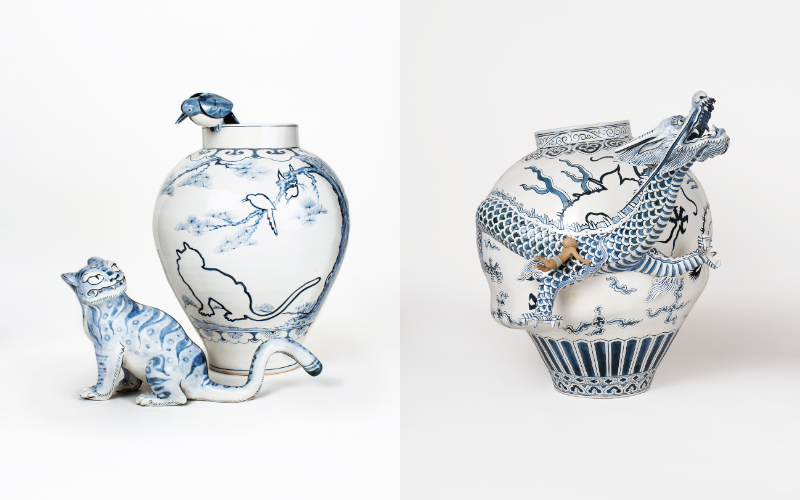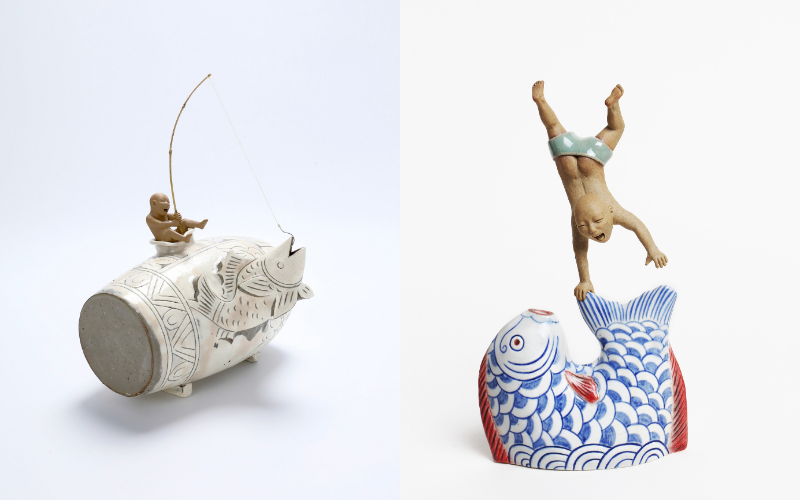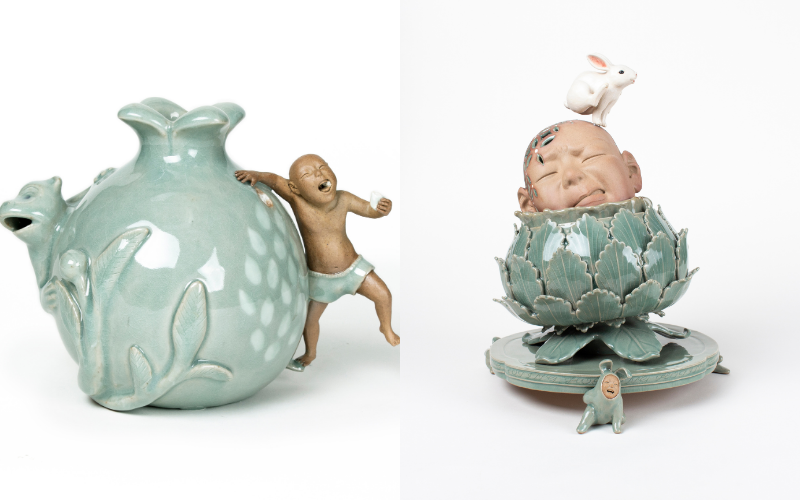Hojun Yoon is a ceramic artist who reinterprets traditional Korean ceramics through sculptural forms. Originally trained in product design as an undergraduate, he found himself uncertain about pursuing a career in that field after graduation. While exploring other possibilities, he happened upon a local ceramics studio. As he began working with clay, he discovered a deep connection to the medium and realized it was the path he had been searching for. In 2012, he enrolled in a graduate program in ceramics, and he has been dedicated to the craft ever since.
Hojun Yoon has participated in numerous notable exhibitions, including "Forest Odyssey" at the Seoul Art Gallery (2025), the special exhibition "Today, Buncheong" at the Gyeonggi Ceramic Museum in Korea (2025), "Korean Ceramic Art: Stories of Near and Far Away" at Korea House in Paris (2024), and ‘’Tell Me Your Wish’’ exhibition at the Marunuma Art Park in Japan (2022).
I was interested in the tiny human figures in his Korean ceramics, celadon, and buncheong pieces. These small figures tell stories and seamlessly combine traditional techniques with his unique artistic voice, forging a connection between Korean ceramic heritage and the artist himself.
The following are excerpts from an email interview with Hojun Yoon between July 7 and August 3, in which he discusses his inspirations in his art and how he pays tribute to Korean ceramic traditions.
1. What are the central themes behind your ceramic pieces?
I borrow images from traditional Korean ceramic relics and create works under the theme of "Indulging in Ceramics" which is about finding joy in traditional ceramics. By adding playful elements to well-known antique ceramics, I intend to help people perceive these relics not just as artifacts frozen in museum time, but as living ceramics that breathe with us in the present.
2. How do you balance honoring Korean ceramic traditions with exploring modern or personal expression?
I try to preserve as much as possible the essential components and feelings present in the original museum ceramics that inspire my work. I devote considerable time to researching and studying their techniques and forms in order to closely resemble the originals. Through this, I hope viewers can both easily recognize the reference and feel a fresh sense of fun by appropriately combining faithful reproduction with creative transformation.

3. Could you explain the meaning behind the tiny human forms in your ceramic works?
A character called "Ah" often appears in my work. "Ah" symbolizes the immature self that accepts traditional ceramic relics as they are and finds pure enjoyment in them. The name comes from the Chinese character "我" ("Ah"), which means "me." This figure is another self, born from projecting my own experiences of discovering and enjoying ceramics. Depending on how "Ah" interacts with the piece, sometimes playing with the form as it is, sometimes blending into or becoming part of the relic, or even animating the original work, each piece takes on a different appearance.
4. How important is preserving Korean cultural identity through your artwork?
Korea has one of the longest histories of ceramics, second only to China. While Korean ceramics first began by imitating Chinese wares, they eventually evolved into distinctive forms, so much so that Goryeo celadon, for example, was highly valued even in China. However, interest in ceramics has waned in recent times. If my work can prompt people to reconsider the originals and appreciate the value and beauty of our ceramics, I believe it can spark greater interest in traditional culture. I hope such efforts contribute, even in a small way, to fostering cultural pride and the ongoing preservation and development of our heritage.

5. Among celadon, buncheong, and other Korean ceramics, which do you enjoy creating the most? Why?
Before I began my "Ceramic Playfulness" series, I was often asked why I made my sculptures in clay. The answer was to create truly "ceramic" ceramics, and I found this particularly in iconic Korean traditions like celadon, white porcelain, and buncheong. I initially started with works inspired by Goryeo celadon, especially figural vases, and then explored painting three-dimensional versions of Joseon white porcelain (often decorated in cobalt blue). Later, I began working with buncheong as well, and now I use all three materials in my practice.
6. What are the biggest challenges you face in your work?
Every new piece feels like a challenge, but converting two-dimensional images into three-dimensional forms has proven the most difficult. It’s hard to simultaneously preserve the essence of the original while creatively transforming it, and the result can easily stray from the intended feel. I rarely achieve the exact shape I first imagined; instead, I make numerous revisions during the process. Particularly when the clay’s moisture or hardness isn’t quite right, making changes can cause cracks or breakage, so I constantly weigh whether to proceed or rework it. More often than not, I choose to revise, making every piece a new challenge.

7. What kind of feedback has your work attracted?
Many people find my work enjoyable, as it often features the playful and cute character "Ah" and familiar ceramics brought to life. Since the themes in my art are not difficult to understand, parents who visit exhibitions with their children also share their own impressions with me. On the other hand, some people feel uncomfortable seeing human forms combined with ceramics, which makes me feel a bit disappointed at times. However, I am also told directly that people sense happiness in the expressions of "Ah," and those moments as an artist bring me great fulfillment.
8. Can you share your future plans or upcoming exhibitions?
I generally participate in group exhibitions two or three times a year whenever there’s an opportunity to showcase my work. Later this year, I will take part in a group exhibition at Incheon Airport. In November, I am also preparing a solo exhibition in Samcheong-dong, Seoul, focusing exclusively on buncheong works.
Hojun Yoon brings new energy to traditional Korean ceramics with his playful and thoughtful sculptures. By adding tiny human figures and personal stories to celadon, buncheong, and other classic styles, he helps viewers connect with Korean culture in a fresh and personal way.
How about this article?
- Like4
- Support0
- Amazing0
- Sad0
- Curious0
- Insightful0


